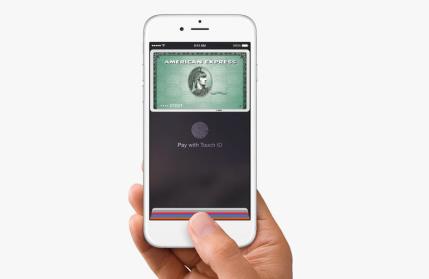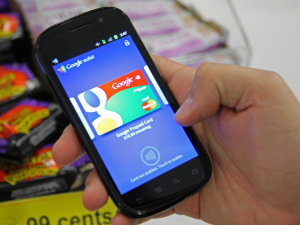Apple Pay Has Company: Samsung Pay, Android Pay

With the recent flurry of media surrounding Apple Pay, I decided to look farther into the product, see the details behind how it worked, how it might change customer behavior, etc. It didn’t take long to figure out that Apple Pay is not alone. Not only has Google Wallet existed since 2011, two more products are on the way: Samsung Pay & Android Pay. Let’s take a look at all these products to see how they compare.
Apple Pay
Some say this product will revolutionize the way we pay for products and services. Tim Cook, CEO of Apple, Inc. said 2015 is “the year of Apple Pay.” Apple Pay takes the upcoming Credit Card transition from Mag strips to chips (set for October 1st, 2015 in the U.S.) a step further by getting rid of the physical card altogether.
With Apple Pay your credit card information is securely stored in the iPhone Passport App and your iPhone effectively becomes your wallet.
To start making purchases with Apple Pay you do the following:
1) Input your credit card and/or debit card data into the Passport App on your iPhone 6 or 6 Plus (this data is encrypted and device specific).
2) Set up the Touch ID function on your iPhone. This feature allows you to sign-in to your iPhone and execute other functions such as Apple Pay with your fingerprint as authentication.
3) Simply hold the iPhone near an Apple Pay compatible reader, or contactless reader, when settling a payment. The iPhone will communicate with the contactless reader through ‘near field communication’ technology and will send an encrypted one-time use only code that represents your credit card information. The Touch ID will be used as authentication.
As you can see, in this scenario 1) a physical credit card is never presented and 2) your actual credit card data is never transmitted to the merchant. Therefore, the merchant doesn’t have the possibility of having your credit card data stolen. If the merchant becomes the victim of a hacking, all that the hacker would get is a one-time use code that is already obsolete.
This summarizes the basic elements of Apple Pay. Some of the security features like the transaction specific code transmitted between your iPhone and the merchant is already underway with the transition to chip-enabled cards. What Apple Pay adds on top of this is the idea that you would not even need to have your credit card on you at all. Therefore further reducing the probability of your sensitive information falling victim to theft. Of course it would take ubiquitous adoption of this technology to really get to that point.
Samsung Pay
The first and most obvious benefit of Samsung Pay is that it brings the technology of Apple Pay to Samsung mobile device users. For now it will only be available on the new Samsung Galaxy S6 and Galaxy S6 Edge phones which hit the market on April 10th.
Samsung Pay is compatible with NFC (near field communication) just as Apple Pay is, however there is one major difference. Samsung purchased a company named LoopPay earlier this year. This company created technology that enables customers to settle payments with mobile devices through traditional mag strip payment processors. This technology has been incorporated into Samsung Pay which means Samsung users can start using Samsung Pay even at retailers that haven’t adopted NFC. This could prove a significant advantage as Samsung users can get used to the idea of mobile payments right away.
Android Pay
Android Pay is not an end-user product like Apple Pay or Samsung Pay. Instead, this product is called an ‘API framework’ as stated by Sundar Pichai, Google’s SVP of Product. API stands for Application Program Interface. The main point here without getting too technical is Android Pay is a framework by which software and app developers can develop end-user products like Samsung Pay. After all, Samsung mobile devices run on Android. Samsung Pay is not run on Android Pay however, but in the future it might be. According to Pichai, the two products are not in competition with each other.

Now don’t forget Google Wallet either. While Google Wallet has been around since 2011 it has not had the penetration that was expected. This is due in part to a competitor named Softcard that was backed by three of the major telecommunications providers: Verizon, AT&T and T-Mobile. Google is now acquiring Softcard and has now struck a deal where any Android mobile device purchased by the major U.S. carriers will feature Google Wallet. The question is will Google Wallet eventually run on Android Pay?
Let’s think for a moment into possibly the very near future… You have an iPhone or an Android mobile device so you have access to one of the new ‘Pay’ mobile payment apps. You also have an app that holds your Bitcoin (Coinbase, Bitstamp, etc). NFC technology is ubiquitous as well as the vast majority of merchants accepting Bitcoin…
Well there you have it. At this point you can purchase anything you need with cash, debit or credit without needing anything other than your mobile device.
Are you ready to let go of your hard cash and credit cards and put your mobile device in its place? Please leave me your comments.